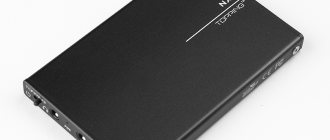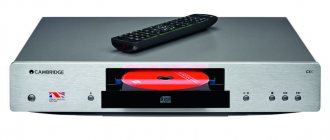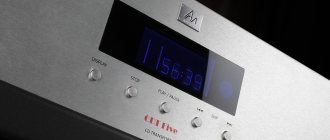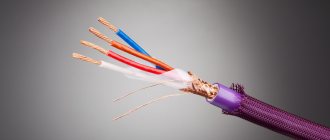Cambridge Audio Azur DacMagic - RUB 15,000.
Sound 4
Design 4
Advantages
Full functionality at a relatively low price
Flaws
No headphone output
The model from the British company Cambridge Audio can be placed horizontally or literally “put into a galosh”: a hard rubber pedestal is included, into which the device stands vertically. The filtering circuit has a double differential virtual ground topology, and the user can select the filter type independently. The USB port accepts a 16-bit/44.1 or 48 kHz signal (signals from 32, 88.2 and 96 kHz are received via optical and coaxial). There is a phase change function.
The sound of FLAC files was subjectively close to what our experts experienced when listening to SACD. when connected to a budget-class editorial DVD player, the “compacts” sounded no worse than on a CD player costing several times more than the aforementioned DVD turntable and DAC combined. The device lived up to its name (magic = magic).
The frequency response is below the average value in the selection. At the edges of the range there is a gentle decline; it does not exceed 0.2–0.3 dB, so it is not critical. Channel imbalance is minimal and does not cause concern. The coefficient of nonlinear distortion is very stable (this can be clearly seen from the graph) and is also within normal limits. The input signal is not inverted. Intermodulation distortion is very small. Spurious harmonics are observed only at frequencies above 20 kHz, and even then at a minimum level - so they do not affect the sound. Overall, the measurements confirm that the stated price of the device is realistic.
EQUIPMENT
The device arrives in a quite presentable box, inside of which lies... That's right - another presentable box. Total - after removing the contents, you can put twice as much trash into the resulting container as expected. Hurray, comrades!
For box-lovers - comparison with the previous version
The content has not changed since the previous model. In addition to the DAC itself, we receive a manual, a USB cable, a power supply, 4 legs with self-adhesive - if you suddenly need them, and an Allen key that allows you to remove the volume knob. Or vice versa - put it in its place.
The DAC itself, apart from the antenna, has not changed in appearance. The color is now only black. It's a shame - I still like white much better.
Comparison with predecessor.
By the way, the antenna has replaced the optical output from the rear panel. Why he was needed there at all - I don’t know, from my point of view the loss is small.
Music Hall dac25.3 — 30,000 rub. — Prize of sympathy.
Sound 5
Construction 5
Advantages
Output amplifier with tube stage
Flaws
Limited lamp life
Understanding that converting “digital” to analog is half the battle; The main thing is to generate a high-quality linear signal; specialists from the American company Music Hall created an output buffer stage on a lamp. The signal from it can only be fed to an unbalanced and adjustable headphone output (the signal goes directly to the balanced output). The USB interface accepts standard (16-bit/44.1 kHz) and high-resolution (24-bit/96 kHz) audio streams, with the ability to upsample up to 192 kHz.
The lamp life is about 1.5 years of continuous operation, so you should not leave the DAC turned on. It effectively clears MP3 files of digital husk, filling them with tube warmth. When playing lossless files, the operating features of the tube stage can lead to some weakening of the bass pressure and clarity of the highs. For lovers of “pristine” sound, a balanced bus is provided.
The frequency response has very little unevenness, with a noticeable rise at the top. However, it is so insignificant (hundredths of a dB) that even a professional musician cannot hear it. The THD graph may scare some people, but we hasten to reassure the reader: it was taken from an asymmetrical input, i.e. from the tube stage, and for the latter it is normal. The balanced output supplies information from SOI an order of magnitude lower. The input signal is not inverted. The ridge of the first-order difference harmonic is clearly visible in the spectrum of the output signal. This is also a tribute that must be paid for the “tube” sound.
Life in digital
The amplitude value is represented by a binary number (1 or 0), and the length of this number is called the bit depth, expressed in bits. The reciprocal of the measurement time interval is the sampling frequency.
For example, when recording a standard CD, samples are taken 44,100 times per second. Each of the “slices” is measured with 16-bit precision, and the measurement results are stored in a 16-bit digital format. On the other hand, when recording a track in Hi-Res audio, the “slice” length increases to 24 bits, and sampling is done as many as 192,000 times per second.
Digital audio data can have a wide variety of sample rates, bit depths, encoding and compression formats - but regardless of the specific parameters, it is the DAC that must give meaning to this data, translating it as accurately as possible from binary format to its original analog form.
Musical Fidelity M1DAC — 21,700 rub.
Sound 5
Construction 4
Advantages
24/192 signal support
Balanced digital input
Flaws
No headphone output
In addition to the DAC, the M1 line of the British company Musical Fidelity includes a CD transport, with which the M1DAC is primarily designed to work. but before us is by no means a narrow specialist. Its rear panel houses not only a USB port, but also other digital inputs up to AES/EBU, as well as single-ended and balanced analog outputs. The conversion circuits are based on the BurrBrown DSD1796 chip, which allows you to convert any input signal into a 24-bit/192 kHz stream and turn it into analog, increasing the accuracy of the transmission of nuances.
On some tracks, the highs were slightly emphasized, but this did not lead to excessive ringing (the percussion was brought to the fore, but many people like this presentation of, say, hardrock compositions). This is only true for "uncompressed" records. With MP3 files everything was simpler and more unambiguous: when played through M1, they noticeably added to their naturalness.
The unevenness of the frequency response approaches the average value for the test, while there is a rather significant (0.2 dB) rise at a frequency of 18 kHz. This leads to a slight emphasis on the highs, so we do not recommend using a DAC with “ringing” bookshelf speakers. The imbalance across channels is negligible. The CNI chart can be called exemplary without a stretch - it, figuratively speaking, spreads along the ground. The phase of the input and output signals is the same. Intermodulation distortion is represented (see the spectrum of the output signal) only as a difference harmonic of the first order and at a negligibly low level (–90 dB).
Audioquest Dragonfly Red/Black
Price: from 7,990 rubles
Audioquest released the original Dragonfly USB DAC back in 2012, but at that time the device's power requirements only allowed it to be used with desktop computers. With modern microcontrollers, the device consumes about 25 mAh and can be successfully powered by any smartphone, including an iPhone via the Lightning port.
The main feature of the Audioquest Dragonfly lies in its size. The device is no different in size from a regular USB flash drive, and therefore fits easily into a pocket along with a smartphone.
The color of the device is not just a design decision, but also an indicator of technical characteristics. Dragonfly Red belongs to the premium class. It has a higher quality converter, the output power is 2.1V as opposed to 1.2V for the black version. This means that Audioquest Dragonfly Red is a better choice for high-impedance headphones.
With my headphones connected directly to the iPhone, music is comfortable to listen to at about half the maximum volume. Through Dragonfly Red the level can be lowered to about a quarter, but with Dragonfly Black, oddly enough, the volume has to be set to just one notch. This means that in the latter case there is no control over the sound at all - if you increase one step, the music plays too loudly, if you decrease it, it turns off completely.
However, both versions of the device very carefully highlight the low frequencies without sacrificing the clarity of the mids. For example, Daft Punk “Get Lucky” without a DAC does not sound as detailed and varied as with it.
Whether it's worth paying extra for the Red version depends on how difficult you find adjusting the volume on your headphones. And when it comes to sound quality, you will notice more changes in good over-ear headphones than in cheap earbuds.
Neither Dragonfly Red nor Black can match the coolness of the Chord Mojo, but their budget price and compact form factor make them a very attractive proposition.
Advantages:
- Very compact.
- Powered by smartphone.
Flaws:
- No detailed settings.
- You may have difficulty adjusting the volume.
NuForce Icon μDAC 2 — RUB 7,000.
Sound 4
Design 4
Advantages
Miniature
Adjustable headphone output
Flaws
Input signal is only accepted via USB
The dimensions and capabilities of the device are dictated by a clearly defined area of application: working with a personal computer or server. This is due to the presence of only one input - USB B. The μDAC also receives supply voltage via USB. The output signal is output in three versions: digital electrical (S/PDIF) and analogue to an unregulated output (2xRCA) and adjustable (mini-jack) for headphones. There are no capacitors in analog circuits, which minimizes phase distortion.
Paradox: the good performance of the device helped our experts find its flaw. in other words, the audio signal from the computer (especially 24/96, with which the μDAC 2 is short-circuited) sounded so natural that I wanted to use this baby with a CD player. Alas, this is not possible - there is no standard digital input. but for those who use headphones to listen to music recorded in the memory of a personal computer, this is an option close to ideal.
This little guy has the lowest frequency response unevenness in the selection... and the second highest SOI level. In absolute value it is not too large (0.02%). There are no complaints about the imbalance between channels. Unfortunately, we were not able to measure the response to a single pulse and do not know whether the input signal is inverted. As for the spectrum of the output signal, it looks completely free from intermodulation interference, but this is a deceptive impression. The fact is that the “rug” here can appropriately be called a flying carpet: it floats at a significant altitude (–80 dB), i.e. the signal-to-noise ratio is 15 dB less than competitors.
What is a DAC?
A DAC is a device that converts information from digital to analog and at the same time improves sound quality (interpretation: digital-to-analog converter).
When using a DAC, the electronic circuit looks like this: audio media > converter > sound. The output supplies current with voltage, which passes through the amplifiers and is supplied to the speaker system. Those. The DAC serves as an “intermediary” between digital and analog standards.
TOP of the best sound amplifiers
DACs are a fast-growing segment of the Hi-End and Hi-Fi markets. And every year the number of models produced only increases.
PS Audio DLIII Digital Link - 30,000 rub.
Sound 4
Design 4
Advantages
Analog circuits operate in class A
Flaws
No headphone output
This product of the American company is based on an interesting philosophy. Since the chips of the DACs themselves are one or two different, the digital path sounds approximately the same. The “voice” of a device is determined by analog circuits, and there are a great many circuits for creating them. For DLIII, transistor analog circuits were chosen that operate in class A with shallow feedback. The solution is audiophile, which, coupled with the presence of balanced outputs and high-quality RCA jacks, allows the device to be addressed to the most demanding music lovers.
Three-stage conversion of the input signal allows you to reduce jitter to a minimum, i.e. improve stereo image resolution. Indeed, the musical images created by the DLIII are surprisingly clear, not a single instrument “bulges out”, but everyone’s voice is clearly distinguishable. If your system allows you to connect DLIII via a balanced bus, we recommend that you take note of the device.
The frequency response and SOI graphs form something similar to a river delta: at the top, nonlinear distortions begin to increase, the amplitude of the input signal decreases (a classic picture of an audio channel operating at the bandwidth limit). The only device in the selection (not counting NuForce, which wished to remain anonymous in this sense) that inverts the phase of the input signal. But there is practically no imbalance across the channels. In the spectrum of the output signal, traces of several difference harmonics are noticeable, but with a fairly low amplitude (–80–90 dB). The “rug” is located at a level of –100 dB, which should be considered a good indicator.
INNER WORLD
Without delay, we will immediately disassemble both pieces of iron.
The board designation is the same, HUD DX-1, the previous model has revision A, the new one has revision C. In general, everything is extremely similar, at the top in the center we see the new NICHICON capacitors announced on the manufacturer’s website, and those same new op-amps in DIP- buildings at the bottom left. They are really easy to change—pry it off with a screwdriver, insert another one, and you’re done. The main difference between the new model (it's on the right) is the bluetooth receiver board inside the tin screen at the bottom right.
Just in case, here’s a separate photo of the controller; you won’t be able to see it in the general photo.
Rega DAC - 38,000 rub. — Prize of sympathy.
Sound 5
Construction 4
Advantages
Five types of output filter
Flaws
No headphone output
The British company Rega, which has vinyl turntables and a High End CD player in its arsenal, is trying to keep up with the times without lowering its demands on itself. The result is a device that can improve the sound quality of any digital audio recording. A signal with a sampling frequency from 32 kHz to 192 kHz is read, but upsampling is not provided. Engineers say: the less manipulation of the input signal, the higher the sound quality. The consumer can choose one of five output filters.
The upper part of the midrange seemed woven from the lightest silk, the top was distinguished by the transparency of a mountain stream, the bass flew around the listening room like an elastic rubber ball. Changing the output filter had no significant effect on the sound, which should also be considered an advantage - rough adjustments are not held in high esteem by audiophiles. The required regime is found after painstaking experiments.
A device that adheres to the principles of moderation and accuracy (remember the classic: “The most worthy two are worth all of us”?). He doesn't have enough stars from the sky, but he works conscientiously. In terms of frequency response unevenness, it shares the palm with NuForce; the imbalance across the channels is microscopic 0.02%. The phase of the output signal is not inverted, nonlinear distortion is negligible over the entire range. In the spectrum of the output signal, traces of two difference harmonics are observed, but their amplitude does not exceed –90 dB, so they should not be taken into account. The mat sits at -105 dB, which is excellent.
Sound
I would like to answer the question posed above by “dancing” from one simple consideration. A person who listens to audio recordings directly from a computer or an inexpensive music server through a Hi-Fi-class stereo system needs a DAC unit like air. In this case, we would not recommend the device with the romantic name μDAC 2 - it is a toy for children, it is more suitable for working with active computer acoustics. Use a miniature Hegel block.
We advise tight-fisted fathers to take a closer look at DacMagic from Cambridge Audio: for a relatively small investment you can bring the sound of computer files to the level of “high fidelity”. If you need to breathe new life into a standard CD or DVD player, pay attention to more expensive devices. It should be remembered that the level of other components (amplifier, and most importantly, speakers) must be appropriate, otherwise you simply will not feel the difference in sound.
The astute reader has already perceived a certain contradiction in this approach. A person assembling a stereo system focuses on components of the same class. Otherwise, you will agree, the process loses its meaning: why connect a budget player to a Hi-Fi amplifier?
However, let’s imagine that the owner decided to upgrade the system and does not want to part with the CD player that has served him faithfully for many years. Another option is even more likely. A home theater is being built, but the AV data source (DVD or BD player) in the guise of a CD player does not suit the owner. An autonomous DAC can solve the problem - any of the participants, excluding Icon μDAC 2. Their “average” sound level is approximately the same; The difference, as always, is in the nuances.
If you're crazy about how a vinyl record plays, then you're in the right place for the Music Hall. This device is equipped with a tube cascade that adds that special coloration to the sound that audiophiles call “warm.” The device has certain musical preferences, but for those who gravitate toward jazz or acoustic music, this is a close to ideal option.
For supporters of assertive transistor sound, we recommend PS Audio. Its analog circuits operate in class A, which makes it possible to reproduce music of any genre with maximum realism. For those who like a creative approach to listening, i.e. For those who want to find the optimal sound option for each favorite composition, we “match” the Rega DAC, which allows you to choose one of five output filter characteristics. Adherents of clear analytical sound will like the Musical Fidelity device.










